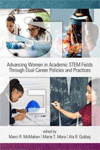
Advancing Women in Academic STEM Fields through Dual Career Policies and Practices
Edited by:
Marci R. McMahon, The University of Texas Rio Grande Valley
Marie T. Mora, The University of Texas Rio Grande Valley
Ala R. Qubbaj, The University of Texas Rio Grande Valley
A volume in the series: Work-Life Balance. Editor(s): Joanne M. Marshall, Iowa State University. Jeffrey S. Brooks, Curtin University. Bonnie Fusarelli, North Carolina State University. Latish C. Reed, University of Wisconsin Milwaukee. George Theoharis, Syracuse University.
Published 2018
Continuing to challenge American colleges and universities is the underrepresentation of women faculty in Science, Technology, Engineering, and Mathematics (STEM) fields, particularly Latinas and other underrepresented women of color. Advancing Women in Academic STEM Fields through Dual Career Policies and Practices, comprised of scholarly essays, case studies, and interviews, argues that to address equity issues related to women faculty, academic institutions should consider work-life perspectives, including dual careers, when designing faculty recruitment, retention, and advancement strategies. By connecting the topic of dual career hiring to gender and ethnicity, the volume extends the current research on work-life integration by sharing best practices and approaches that have worked among institutions of higher education while incorporating issues related to intersectionality.
CONTENTS
Acknowledgments. Foreword by the Editors, Marci R. McMahon, Marie T. Mora, and Ala R. Qubbaj. PART I: INTRODUCTION AND OVERVIEW. Perspectives from an NSF ADVANCE Program Director, Beth Mitchneck. Women in Academic STEM: Dual Career and Work–Life Perspectives, Lisa Wolf-Wendel and Kelly Ward. PART II: CHALLENGES, OPPORTUNITIES, AND BEST PRACTICES. The Dual Career Conundrum: Holistic Hiring—More Matters, Angela McNerney. Partner Accommodation in the Hinterlands: A Strategic Imperative for Faculty Retention, Susan K. Gardner and Angela McNerney. Transitioning From “Two-Body Problem” to “Dual Career Opportunity”: A Long and Arduous Journey, Christine L. Kaunas, Lesley Tomaszewski, and Sherry J. Yennello. Building a Dual Career Program: Myths and Realities, Phyllis Brust, Lesley Lundeen, and Rebecca Parker. Interview: Dual Career Hiring at Harvard and the Higher Education Recruitment Consortium, Elizabeth Ancarana and Marci R. McMahon. PART III: RECRUITMENT AND RETENTION WITH A FOCUS ON INTERSECTIONALITY. ADVANCING Latinas and Other Women in STEM Through Dual Career Hiring and Other Policy/Climate Initiatives at the University of Texas Rio Grande Valley, Marie T. Mora, Ala R. Qubbaj, and Havidán Rodríguez. Interview: Dual Career Hiring and Other NSF ADVANCE Initiatives at the University of California Davis to Increase the Representation of Latinas and Other Women in STEM, Karen McDonald, Mary Lou de Leon Siantz, Denneal Jamison-McClung, Linda Bisson, Linda L. Assadian, Binnie Singh, Maureen Stanton, and Marie T. Mora. Choosing the Best: Successful Practices for Increasing the Number of Female Faculty in the Industrial Engineering Department at the University of Puerto Rico at Mayagüez, Sonia M. Bartolomei-Suárez and Luisa Guillemard-Gregory. Afterword on Lessons Learned. About the Editors. About the Contributors.
-
Paperback978-1-64113-242-8
Web price: $45.04 (Reg. 52.99)
-
Hardcover978-1-64113-243-5
Web price: $80.74 (Reg. 94.99)
- eBook978-1-64113-244-2

- EDU046000 - EDUCATION: Professional Development
- SOC028000 - SOCIAL SCIENCE: Women's Studies
- EDU015000 - EDUCATION: Higher
-
 Abriendo Puertas, Cerrando Heridas (Opening doors, closing wounds)
Latinas/os Finding Work-Life Balance in Academia
Abriendo Puertas, Cerrando Heridas (Opening doors, closing wounds)
Latinas/os Finding Work-Life Balance in Academia
-
 Beyond The Pride and The Privilege
The Stories of Doctoral Students and Work-Life Balance
Beyond The Pride and The Privilege
The Stories of Doctoral Students and Work-Life Balance
-
 Bounding Greed
Worklife Integration and Positive Coping Strategies Among Faculty of Color in Early, Middle, and Late Career Stages at Comprehensive Universities
Bounding Greed
Worklife Integration and Positive Coping Strategies Among Faculty of Color in Early, Middle, and Late Career Stages at Comprehensive Universities
-
 Gender, Tenure, and the Pursuit of Work-Life-Family Stability
Gender, Tenure, and the Pursuit of Work-Life-Family Stability
-
 Identity Intersectionalities, Mentoring, and Work–Life (Im)Balance
Educators (Re)Negotiate the Personal, Professional, and Political
Identity Intersectionalities, Mentoring, and Work–Life (Im)Balance
Educators (Re)Negotiate the Personal, Professional, and Political
-
 On the High Wire
Education Professors Walk Between Work and Parenting
On the High Wire
Education Professors Walk Between Work and Parenting
-
 Parenting in the Pandemic
The Collision of School, Work, and Life at Home A Collection of Essays
Parenting in the Pandemic
The Collision of School, Work, and Life at Home A Collection of Essays

